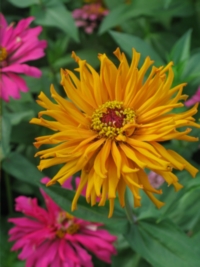
While September can still be excruciatingly hot, it is during this month that we start really noticing the days getting shorter and can perhaps glimpse some end in sight to Summer. Certain plants in our gardens are sensitive to this change and can help clue us in. For example, like magic, last week I noticed the first Oxalis leaves sprouting in my garden. I also saw a nasturtium seedling volunteering in an old planter that had been bare for months. These are hints that times are changing!
Day-length in the plant world is called a photoperiod and many plants are photoperiodic, meaning they begin or stop blooming in reaction to the photoperiod. Ever hear that artificial light from a streetlight or outdoor floodlight can keep a poinsettia from blooming? Or that you can put a Christmas Cactus in a dark closet to make it bloom? These plants are photoperiodic and are actually responding to the number of hours of darkness, not hours of light. Plants can be termed Short-day plants or Long-day plants. Some plants that are considered Long-day plants, requiring fewer than a certain number of dark hours include Dianthus, Clover, Rye Grass, Peas, Lettuce, and Turnips and will typically flower in late Spring as days are getting longer (and nights shorter). Short-Day plants that cannot flower until nights reach a certain length include Chrysanthemum, Poinsettia, Cotton, Rice and Sugar Cane. Other plants such as Roses, Tomatoes and Cucumbers are considered Day-Neutral, blooming in response to temperature or other stimuli regardless of day/night length. Many, many of the cut flowers you are familiar with through the floral industry are “forced” to bloom on demand by the growers’ manipulation of the photoperiod through some form of artificial lighting.

September is for seeds! Now is not only the time to be collecting seeds from fading Zinnias, Gomphrena, Tithonia, Rudbeckia, Gaillardia and other summer annuals that will soon be replaced in the garden, but it is prime time for starting new seeds for spring vegetables, herbs and all of the many cool-season flowers. Many don’t realize that our Spring actually starts in the Fall. When you read on a seed packet to “start your seeds after all danger of frost is passed,” to us, that means NOW, in the Fall. If you wait until March or April like elsewhere in the country, it’s too late and summer heat is upon you before your plants can make their show. An early start is especially beneficial for vegetables and flowers that need many weeks, even months to mature like Brussel Sprouts, Cabbages, Cauliflower, Broccoli and (if you’re brave and/or very talented) Cauliflower, as well as flowering plants like Delphinium, Foxglove, Snapdragon, Ornamental Cabbages, Viola, Pansy and Dianthus. While these starts may just creep along through the winter, the long, slow growing period will yield much larger, more impressive plants when they finally take off during the lengthening days of Spring. Some care needs be taken with tender cool-weather flowers like Dahlia, Marigold, Nasturtium and some others during freezing weather or frosts, but if protected occasionally during the winter they will reward you quickly come spring time. The vast majority of others cool-season flowers are completely impervious to our mild frosts and freezes and there is no need to baby them through any cold spell. Faster maturing plants, like petunias, nasturtiums, and marigolds will even provide you with some fall and winter flowering until the days get so short that they stop for a time.

So, now into October, you can start seeds for Parsley, Dill, Fennel, Thyme, and Sage as well as Cosmos, Baby’s Breath, Larkspur, Alyssum, Petunias, Columbine, Coreopsis, Echinacea, Viola, Pansy, Strawflower, and a multitude of others. Experiment!
Many summer annuals are still doing well in our gardens, some too well! Pentas, torenia, begonias and dwarf zinnias like Profusion or Linear zinnias may be overgrown or simply too large for their space in the garden. They can be cut back or even sheared back and will still fill back out nicely, even rejuvenating somewhat from the removal of all of those energy-consuming seed heads. You can apply liquid fertilizer to give them a needed boost since they’ve been going strong for many months now.
Avoid harsh pruning of most shrubs and woody plants this time of year. This only stimulates new, tender growth which may be more susceptible to cold weather in a couple of months and many of our woody shrubs like azaleas, hydrangeas and gardenias have already set their buds for next year’s blooms.
Roses benefit greatly from cutting back by about one third now before they flush out and return to glory in the cooler weather of October.
Keep deadheading basil and coleus to prolong their season. Trim dying leaves from Caladiums to keep tidy. Caladiums can be dug, dried and stored when over a third of their leaves have lain down, but no rush, they often last into late October.
submitted by Tammany Baumgarten
